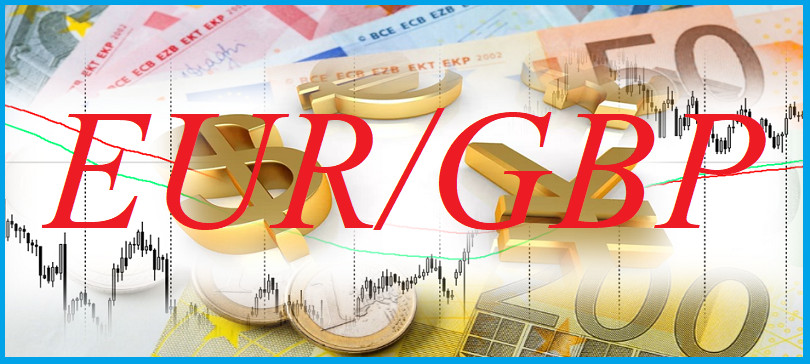
- EUR/GBP belongs to the category of cross-pairs and shows how many units of the national currency of the UK (pound) you need to pay for one euro, which is the legal tender of 19 countries (as of July 2022) that are members of the eurozone (Austria, Belgium, Germany, Greece, Ireland, Spain, Italy, Cyprus, Latvia, Lithuania, Luxembourg, Malta, the Netherlands, Portugal, Slovakia, Slovenia, Finland, France, Estonia), and the national currency of four more states and eight special territories of the EU.
- The base currency in the EUR/GBP pair is the euro. This means that the commodity in the EUR/GBP pair is the euro, and the pound (pound) is the second currency in the pair, with which the base currency (the euro) is bought. By themselves, the euro and the pound are included in the IMF basket, which consists of five major world currencies (in descending order): US dollar, euro, yuan, yen, and pound. At the same time, the euro and the pound are the world's reserve currencies.
- At the moment (July 2022), the EUR/GBP pair is trading on the Forex market at a price above 0.8500. This means that for one euro they give 0.8500 pounds
Features of trading the EUR/GBP pair
1.1. Both the euro and the pound, as well as the EUR/GBP pair, are characterized by high liquidity. Almost at any moment there will be both bulls and bears for the pound or the euro. However, the largest trading volumes for the EUR/GBP pair are typical for the European session. Moreover, the first two or three hours at the beginning of trading in London are the most active in trading with the EUR/GBP pair. Further, the activity of trading in the EUR/GBP pair falls, and the lowest trading volumes for the pair are typical for the Asian session.
1.2. Until June 23, 2016, the UK was part of the European Union. However, the country was not part of the eurozone and retained the national currency (pound) as a means of payment.
1.3. Following the results of the referendum held in the country on June 23, 2016, the UK leaves the European Union. At the beginning of 2017, the pound lost about 20% in value, but then partially returned the lost ground. The sharp weakening of the pound was also reflected in the EUR/GBP pair, which lost about 800 points in six months after the Brexit referendum.
In August 2016, the Bank of England lowered the interest rate in the country to 0.25%, and in March 2020 (due to the coronavirus pandemic) to 0.1%, the lowest in 300 years. During the next economic forum in Jackson Hole, held at the end of August 2020 via videoconference, the current head of the BoE, Andrew Bailey, said that the British central bank still has enough room to ease monetary policy, including through the introduction of negative interest rates and expanding the range of assets purchased by the bank. "We haven't exhausted our options yet," Bailey said.
However, the sharp increase in inflation forced the BoE to move into a cycle of tightening its monetary policy at the end of 2021, following the example of other major global central banks. As of July 1, 2022, it was already 1.25%.
1.4. In connection with the UK's exit from the European Union, many economists painted a gloomy outlook for the UK economy and the pound. At the same time, the collapse of the economy did not happen, and quite positive macroeconomic indicators have been coming out lately.
1.5. The UK has the second largest economy in Europe (after Germany). Germany, whose economy is the locomotive of the eurozone, at the beginning of 2020 was in 5th place in the world in terms of GDP (3.13%), the UK was in 9th place (2.21%). At the beginning of 2017, Germany was in 4th place in the world in terms of GDP (4.5%), and the UK was in 5th place (3.9%).
1.6. The burst of trading volatility in the EUR/GBP pair falls, in addition to the release of news of a political nature, during the period of publication of important macroeconomic indicators for the eurozone, Germany, Great Britain and the United States. The following macroeconomic factors and indicators give the greatest volatility to the EUR/GBP pair:
- Decisions by the BoE and the European Central Bank regarding monetary policy in the UK or the eurozone;
- Speeches by the heads of the BoE and the ECB (currently Bailey and Christine Lagarde, respectively);
- Publication of minutes from the latest meetings of the BoE and the ECB on monetary policy issues;
- Data from the UK labor market, eurozone, Germany;
- GDP data for the UK, eurozone, Germany;
- Publication of inflation indicators for Great Britain, eurozone, Germany.
Strong macroeconomic indicators in the UK or the euro area lead to the strengthening of the pound or the euro, respectively, as contribute to the growth of "tough sentiment" of the central banks of the UK or the eurozone regarding an increase in interest rates. And this is a positive factor for the national currency, which leads to an increase in its value.
1.7. Important political events in the UK, the euro area and in the world also affect the quotes of currencies and, above all, the pound and the euro. The sale of assets on the stock markets of Europe leads, as a rule, to an increase in the value of the euro, including in the EUR/GBP pair. And vice versa. The growth of the stock market in the euro area, as a rule, is accompanied by a decrease in the value of the euro. The same can be said about the pound and the British stock market, which have an inverse correlation (in relation to the national currency and stock indices), although much less noticeable compared to the reverse correlation of the dollar and US stock indices.
1.8. Even five or six years ago, the EUR/GBP pair was considered one of the most "calm" currency pairs. Now, due to the increase in political and economic risks in the world, the former "calm" is a thing of the past. The intraday volatility of the EUR/GBP pair today averages 100 points, but can exceed 150-200 points during periods of important news of a political or economic nature, and not only in the UK or the eurozone. Now EUR/GBP is a pair with fairly high intraday volatility, low predictability, especially intraday, high inertia and protracted trends. When trading this pair, it is also necessary to take into account that the cost of one price pip is relatively high. The best trading time for this pair is the end of the trading day and the US session, the strategy is scalping.













